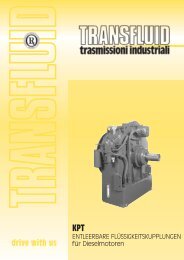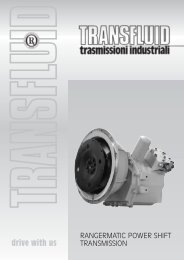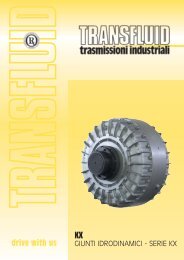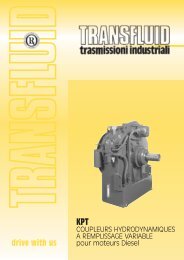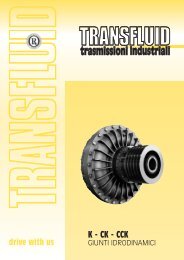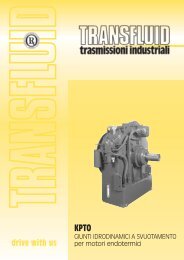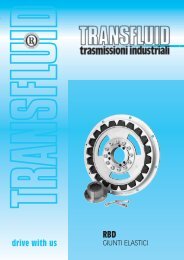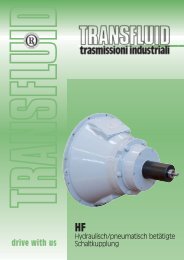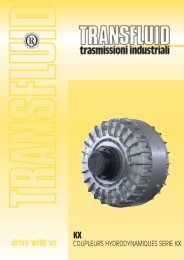K - CK - CCK - Transfluid
K - CK - CCK - Transfluid
K - CK - CCK - Transfluid
You also want an ePaper? Increase the reach of your titles
YUMPU automatically turns print PDFs into web optimized ePapers that Google loves.
DESCRIPTION & OPERATING CONDITIONS<br />
1. DESCRIPTION<br />
The TRANSFLUID coupling (K series) is a constant fill type,<br />
comprising of three main elements:<br />
1 - driving impeller (pump) mounted on the input shaft.<br />
2 - driven impeller (turbine) mounted on the output shaft.<br />
3 - cover, flanged to the outer impeller, with an oil-tight seal.<br />
The first two elements can work both as pump or turbine.<br />
2. OPERATING CONDITIONS<br />
The TRANSFLUID coupling is a hydrodynamic transmission. The<br />
impellers perform like a centrifugal pump and a hydraulic turbine.<br />
With an input drive to the pump (e.g. electric motor or Diesel<br />
engine) kinetic energy is transferred to the oil in the coupling. The<br />
oil is forced, by centrifugal force, across the blades of the pump<br />
towards the outside of the coupling.<br />
The turbine absorbs kinetic energy and generates a torque<br />
always equal to input torque, thus causing rotation of the output<br />
shaft. Since there are no mechanical connections, the wear is<br />
practically zero.<br />
The efficiency is influenced only by the speed difference (slip)<br />
between pump and turbine.<br />
The slip is essential for the correct operation of the coupling -<br />
there could not be torque transmission without slip! The formula<br />
for slip, from which the power loss can be deduced is as follows:<br />
input speed – output speed<br />
slip % =<br />
input speed<br />
x 100<br />
In normal conditions (standard duty), slip can vary from 1,5%<br />
(large power applications) to 6% (small power applications).<br />
TRANSFLUID couplings follow the laws of all centrifugal<br />
machines:<br />
1 - transmitted torque is proportional to the square of input<br />
speed;<br />
2 - transmitted power is proportional to the third power of input<br />
speed;<br />
3 - transmitted power is proportional to the fifth power of circuit<br />
outside diameter.<br />
1<br />
OUTPUT<br />
INPUT<br />
INPUT<br />
OUTPUT<br />
4<br />
3<br />
2<br />
1 - INTERNAL IMPELLER<br />
2 - EXTERNAL IMPELLER<br />
3 - COVER<br />
4 - FLEX COUPLING<br />
Fluid couplings - 0808 2



